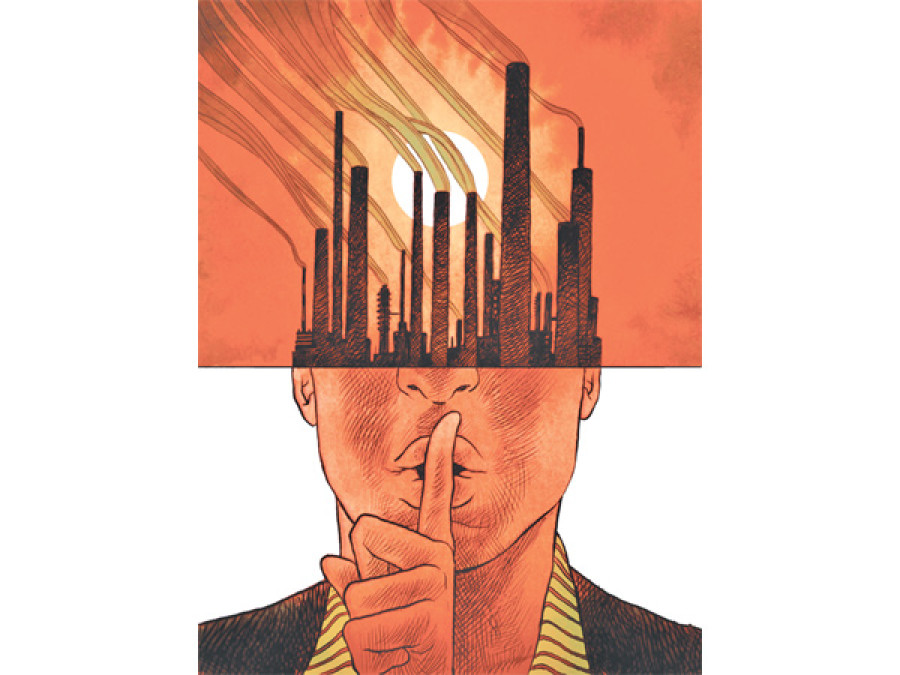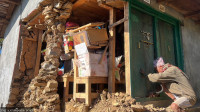Opinion
Something in the air
Due to air pollution, chronic obstructive pulmonary diseases continue to rise in the Valley
Sandhya Regmi
The impact of air pollution on human health can be detrimental and irreversible whether the pollution comes from industrial accidents or normal incidents. In what is considered to be the world’s worst industrial disaster, Bhopal’s methyl-isocyanate gas leakage in 1984
killed over 8,000 people and injured over 500,000. Similarly, the Chernobyl nuclear power plant disaster in 1986 released radioactive particles into much of Europe’s atmosphere leading to an eventual death toll of 4,000 and radiation exposure to 586,000.
The effects can be no less devastating even if industries purport to be operating normally. In Donora, Pennsylvania, 43 percent of the population became ill and 20 died in 1948 due to an excess of sulphur dioxide and particulate matter in the ambient air. In London, thick fog and temperature inversion killed 4,000 in 1952. King’s College reported that 9,500 Londoners had their lives shortened by air pollution in 2010, accounting for a fifth of all deaths in the city that year. The effect was deadliest in areas with the heaviest traffic. In Sao Paulo, Brazil, air pollution killed 4,655 people in 2011, accounting for more than twice the number of deaths from AIDS (874) and breast cancer (1,277) combined. Quite recently on September 8, an unseasonal suffocating sandstorm hit Lebanon leading to five deaths and 750 cases of asphyxiation or shortness of breath.
Alarming scenario
Throughout the world, hundreds of such incidents with alarming levels of air pollution are compromising human health. Almost a decade ago, the World Health Organisation (WHO) had estimated that about three million people die prematurely annually due to health complications caused by air pollution, out of which 30 percent die due to lung cancer, cardiovascular and respiratory diseases. And among these deaths, 150,000 reportedly occur in South Asia. In a new report, WHO has estimated that due to air pollution 7 million deaths occur annually, one in eight of total global deaths. This finding more than doubles the previous estimates and confirms that air pollution is now the world’s largest single environmental health disaster. A recent research by the Harvard School of Public Health has also revealed that non-smokers living in areas with high levels of air pollution are 20 percent more likely to die from lung cancer.
The people of Kathmandu are no exception. The health impact of air pollution depends mainly on the type and concentration of the pollutant, exposure duration and the age and health condition of a person. In what is probably the first comprehensive study of its kind, the World Bank has published the health impacts of PM10 (the annual average concentration of particulates of size 10 micron or smaller) in Kathmandu. It estimated that about 19,000 cases of asthma and hundreds of cases of bronchitis and other health-related disorders were caused due to the air pollution.
Sickening agents
Clean Energy Nepal, a non-profit organisation, has also investigated the trend of air pollution related diseases in the Kathmandu Valley, by analysing the data of inpatients admitted to the three largest public hospitals here, namely Bir Hospital, Teaching Hospital and Patan Hospital, in the last 10 years. The study showed that the number of patients suffering from chronic obstructive pulmonary disease (COPD) nearly doubled during the review period. Incidences of COPD increased about 30-50 percent during the winter season, which is explained by the thermal inversion
phenomenon in the cup-shaped valley exacerbating the air pollution problems in the cold months. Further, case studies conducted among child labourers and traffic police officers exposed to vehicular pollution, and among children and adults living in the vicinity of brick kilns, indicated that a large proportion of those exposed to air pollution had a remarkably high degree of air-pollution-related health disorders.
Apart from PM10, the pollutants in the valley that are believed to be dangerous to human health are sulphur dioxide, nitrogen dioxide and carbon monoxide—all emitted by motor vehicles and industries. Arguably, vehicular emission is the biggest culprit; and if this is not reduced, the level of toxins and carcinogens in Kathmandu’s air will keep increasing. Oxides of nitrogen are extremely dangerous to human health, causing shortness of breath, wheezing, asthma attacks and chest pain, which can also lead to heart attack. The worst thing is that these toxins react with the volatile organic compounds in the presence of sunlight to produce tropospheric ozone, the so-called bad ozone which is the major ingredient of photochemical smog—one of the most dangerous air pollutants.
Possible initiatives
None of the 3.5 million people of Kathmandu are immune to air-pollution-induced health hazards. With an ever increasing number of vehicles and factories in the valley, the breathing exercise is becoming only more hazardous. Having diagnosed the cause, in theory, the underlying solution is simple: ban all substandard vehicles, substandard fuels and polluting factories in the valley. Promote environment-friendly mass transportation with efficient engines that consume less fuel or operate on electric or solar power. Plant more trees that absorb carbon emissions. Monitor the pollution level daily to measure the progress of the effort.
And if need be, implement air pollution control technologies to convert harmful pollutants into harmless or less objectionable forms through mechanisms such as absorption, combustion, condensation and chemical treatment with the use of cyclones, electrostatic precipitators, filters and scrubbers. To cleanse the air of the Valley, all of us—the general public, industries, I/NGOs, media, watchdogs and the state—can and must work to that end.
Regmi is an environmental engineer with specialisation in air pollution from the National University of Singapore




 12.12°C Kathmandu
12.12°C Kathmandu










